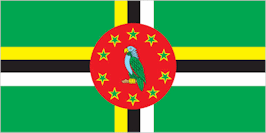Dominica - Climate
 The Climate is tropical; moderated by northeast trade winds; heavy rainfall. The heat is made ten-fold oppressive by the moisture-laden atmosphere.
The Climate is tropical; moderated by northeast trade winds; heavy rainfall. The heat is made ten-fold oppressive by the moisture-laden atmosphere.
The country’s climate is tropical in nature, with micro climates a consequence of its mountainous terrain. Annual temperatures average between 26 – 27 degrees Celsius in coastal areas decreasing to 19 – 21 degrees Celsius in mountainous areas, and with night time temperatures varying from 18 – 22 degrees Celsius on the coast to 10 – 12 degrees Celsius at higher elevations.
Dominica ranks among the wettest islands in the Eastern Caribbean with annual rainfall of over 400 inches (10,000 mm). However the island experiences a dry season from February to June. Since the island lies within the Atlantic hurricane belt, it is very susceptible to the impacts of hurricanes from June to November each year.
Recent observations of the impacts of climate change and the interactions with biodiversity and ecosystems reveal that there have been alterations in the species diversity of some of Dominica's ecosystems. A growing phenomenon of grass lands (locally called mulch) on the west coast could be attributed to climate change impacts. These have been found to be a major source of bush fires in Dominica. Furthermore patterns of rainfall, along with increased temperatures have changed dramatically and there has been recorded an increase in disease and pest occurrences as evidenced in the invasive species like to sargassum seaweed and lion fish among others.
Impacts of climate change and weather variability continue to be a challenge for planners and a test for national capacities in adaptation and response. Global Circulation Models (GCMs) serve as important tools in providing future climate information for Dominica.
Dominica has been able to take advantage of its rugged terrain, unexploited rainforest and rare species of fauna as tourism attractions given that it does not have white sandy beaches, a typical Caribbean tourism offering. The country is already experiencing some of the effects of climate variability and change through damages from severe weather systems and other extreme events, as well as more subtle changes in temperatures and rainfall patterns.
Detailed climate modelling projections for Dominica predict:
- an increase in average atmospheric temperature;
- reduced average annual rainfall;
- increased Sea Surface Temperatures (SST); and
- the potential for an increase in the intensity of tropical storms.
And the extent of such changes is expected to be worse than what is being experienced now.
As a result of its mountainous topography, the majority of infrastructure and settlements in Dominica, including government, health, commercial and transportation facilities, are located on or near the coast and these areas already face pressure from natural forces (wind, waves, tides and currents) and human activities, (including inappropriate construction of shoreline structures). The impacts of climate change, in particular Sea Level Rise [SLR], will magnify these pressures and accelerate coastal erosion.
Some tourism infrastructure is more vulnerable than others. A 2 m SLR places 6% of the major tourism properties at risk. Road networks are particularly vulnerable with 15% of roads inundated with a 2 m SLR and 50% of airport lands inundated with a 2 m SLR. It is important to note that the critical beach assets would be affected much earlier than the SLR induced erosion damages to tourism infrastructure.
The beaches of Dominica have been monitored since the mid-1980’s by the Forestry, Wildlife and Parks Division, indicating there is change from season to season and from year to year, but the underlying trend in the majority of locations has been a loss of beaches due to accelerated erosion, with accretion in a few beaches (e.g. Soufriere and Batalie).
Projections from the General Circulation Model (GCM) ensemble indicate an increase spanning 0.8 - 3.0°C in mean annual temperatures by the 2080s. Regional Climate Model (RCM) projections driven by ECHAM4 and HadCM3 indicate greater increases in temperature over Dominica than the median change projected by the GCM ensemble under a higher emissions scenario.
GCM projections of rainfall span both overall increases and decreases, ranging from of -35 to +14 mm per month by 2080 under a higher emissions scenario. Most projections tend toward decreases. The RCM projections, driven by HadCM3 boundary conditions, indicate large decrea se in annual rainfall (-26%) when compared to simulations based on ECHAM4 (-6%).
Sea Surface Temperatures (SST) GCM projections indicate increases in SST throughout the year. Projected increases range from +0.7°C and +2.9°C by the 2080s across all three emissions scenarios.
North Atlantic hurricanes and tropical storms appear to have increased in intensity over the last 30 years. Observed and projected increases in SSTs indicate potential for continuing increases in hurricane activity and model projections indicate that this may occur through increases in intensity of events but not necessarily through increases in frequency of storms.
|
NEWSLETTER
|
| Join the GlobalSecurity.org mailing list |
|
|
|

